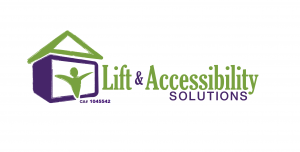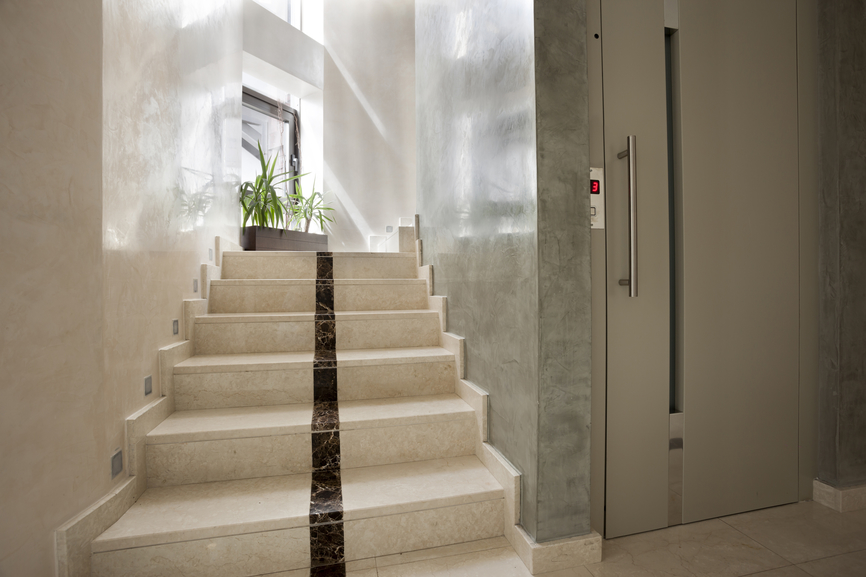07 Feb 2017
Installing a Chairlift in Your Home
Earlier, we discussed pricing, options, and other information about installing an elevator in your home. Today, we’re going to look at an option that appeals to many people because, in part, is a more economical choice: installing a chairlift.
What Is A Chairlift?
A chairlift is pretty much exactly what it sounds like: it is a motorized chair installed on a special rail system. Like an elevator, it is designed to help move its occupant safely, quickly, and conveniently up or down a floor in a building. Unlike an elevator, though, which requires a special area to be built to house the elevator cab as well as other modifications, a chairlift is a relatively easy installation because it is designed to smoothly travel up or down a flight of stairs. This means that the chairlift installation is a much easier process than an elevator, and even better: it tends to be much cheaper as well.
What Are The Types Of Chairlifts?
Generally speaking, there are two types of chairlifts (also known as stair lifts, or stair chairs) to choose from, and the choice depends on what type of staircase you already have in your home. Straight chairlifts are installed on a straight staircase that simply goes up and down in a straight line. Curved chairlifts are installed on a curved staircase. Because curved staircases are generally unique in their design, a curved chairlift usually requires a little bit of customization, which can affect the overall price.
Installation And Price
Typically, a straight chairlift is a straightforward process (no pun intended). As most chairlifts are already constructed before you purchase them, there is very little time between buying one and its installation. Permits will be required, and are a separate charge.
As many staircases, even straight ones, can be a little different when it comes to things like angle of descent, etc., it does take a little bit of adjusting to make sure the rail system is installed properly. In addition, details such as stair material can influence the difficulty of the installation, and, therefore, the price. If the stairs have unusually long steps, platforms, or are situated far from an electrical source, those factors can also have an impact on the bottom line.
Curved lifts are a little trickier. In this case, the railing system often needs to be custom-made to fit the particular needs of your staircase. This can also affect the price. Other things that can alter the price include the quality of the chair itself, the motor you wish to install (which will have an impact on the final speed of the chair), and any other customization you wish.
In the end, though, installing a chairlift is a relatively easy and cheap process that can help restore mobility and independence. If you are interested in learning more about the process and how we can help you, please don’t hesitate to contact us today!
06 Jan 2017
4 Reasons Why People Avoid Getting A Stairlift
Stairlifts are a useful tool to help individuals who have difficulty walking up and down stairs or who use a wheelchair. A stairlift, also known as a wheelchair lift, stair glide or chairlift, is a collapsible chair attached to a mechanical device that lifts a person up a set of stairs and back down them. If a person has a disability that may become progressively debilitating such as arthritis or COPD, their occupational therapist (OT) or physician may suggest they get a lift. However, it’s not always easy for individuals to use assistive technology. Here are four statements illustrating why people avoid getting a stairlift:
1. “I’m not ready for this change.”
There is a lot of emotion involved when changes to one’s independence occur. The loss of mobility can have a profound effect on a person’s mental health. It’s important to care for your emotional health and speak with your doctor or a counselor to help you to process the changes in your life.
2. “I don’t want to make structural changes.”
You may be concerned that there will be damage or changes to the structure of your home, but the installation is very discreet. The chair is attached to the lift, and the lift is installed with support brackets and screws.
3. “I don’t have enough room.”
Some customers are worried that the lift won’t give enough room for someone else to use the stairs without using the lift. Another concern is that the stair will block the landing. Stairlifts are designed, chosen, and installed to prevent such a situation. Many stairlifts today have folding foot rests and seats so they take up a minimal amount of space when not in use.
4. “I can’t afford it.”
The cost of a stairlift can vary but can cost up to several thousand dollars. Caregivers may be concerned about costs affecting their aging parents. Customers may have concerns because of a fixed budget. Unfortunately, lifts are not covered by Medicare, but there are other opportunities to fund the cost. Veterans may be eligible for coverage through the Veteran’s Administration (VA) or federal grants. You can apply for local, state or Federal grant funds to make home improvements. Medicaid may cover the cost. You may also be able to negotiate with the dealer to purchase a used lift or to set up a payment plan to help.
A stairlift is an excellent solution to help seniors or persons with disabilities to live safely in their homes. Don’t wait to get the assistive technology you need to help you to maintain your independence.
Want to know more? Download the free e-book, “Stair Lifts: 14 Things You Must Know Before You Buy.”
Part of the aging process means accounting for physical changes that can reduce one’s mobility. Whether individuals decide to age in an assisted living facility or in their homes is dependent on costs, needs and resources. The decision to remain in one’s home often means changes must be made to accommodate safety and accessibility. Contractors and companies that specialize in making homes accessible and safe for aging seniors can help. Living in one’s home throughout the aging process does not have to become an impractical choice or beyond one’s financial reach. Although needs may change, simple and affordable home modifications can make it easier to live safely. The following represents the top things seniors and their loved ones should consider before making structural changes to their homes:
1. Needs: What are your specific concerns and needs related to safety and accessibility? Seniors that use a wheelchair or walking equipment will likely need to replace stairs with ramps or stair lifts for greater accessibility. Consider whether it makes practical sense to make changes to any outdoor or indoor stairwells. What areas of the house will you continue to use? Some seniors decide that replacing an indoor staircase with a ramp is unnecessary if they do not need to gain access to specific portions of the house. For instance, a live-in caregiver may reside within the areas that are accessible via the staircase and the separation will serve both parties well.
2. Costs: What will it cost you to make the necessary changes to your home? Will you need financial assistance? It is best to make a list of the changes you will need to make and get an estimate from a licensed contractor. If the changes involve the purchase and installation of stair lifts, decks, ramps, support bars, and elevators, research the anticipated costs with several companies. These types of changes can range from hundreds to thousands of dollars. Several agencies and volunteer organizations, such as the Area Agencies on Aging (AAA), may be able to provide financial assistance. Mortgage lenders may also offer products that can supply funds to pay for upgrades.
3. Modifications: Does carpet need to be removed and replaced with a slip-resistant alternative? Is any laminate or wood flooring potentially unsafe? Sometimes simple changes such as a rug will do the trick. Do the bathrooms need to have support bars or special tubs and showers installed? Do doorknobs and handles need to be replaced with arthritis-friendly levers? These are questions about modifications you will want to ask before contracting any work that needs to be done. It is best to list all modifications ahead of time so that all equipment and work that needs to be completed can be done at the same time.
Overall, these are some things to consider when making your Santa Rosa, CA home more accessible to seniors. Whether you are making changes to your home for yourself or for your loved ones, think about the needs, costs, and modifications involved so you can be fully prepared.
01 Dec 2015
Picking the Right Stairlift For Your Needs
For the elderly and infirm, nothing is taken for granted. Actions and movements that were once easy become difficult or downright impossible as we get older. For example, climbing a flight of stairs can be a cumbersome or painful task for many older citizens, especially if they require assistance to move around, such as a wheelchair. Fortunately, however, there are options to enable anyone to live and move freely within their home, even if stairs have become more of a hassle. Stair Lifts are designed to carry a person up and down a flight of stairs comfortably and safely. However, not all lifts are built the same; so how do you choose which one is right for you? What is usually comes down to is size, power needs, and installation requirements. Below we’ll outline what options are available and how to make the right choice.
Size
When it comes to size, there is a range of factors that you have to take into account. First, is your personal size. Most lifts are rated for 150-250 pounds, so if your body type exceeds this range, you’ll need to opt for a larger lift. Size also refers to the lift itself. Most are designed to carry only one person, without any heavy additions, such as a wheelchair. As a result, most lifts are relatively small, and many fold up so as not to block the stairway. When considering a lift, make sure to take into account the size of both the lift and of yourself to ensure that everything works, and fits, properly.
Power Needs
There are two types of stair lifts, those that run on your home’s electrical grid, and those that operate on a battery. The benefit of an AC lift that is powered from your home is that it requires less maintenance and costs less in the long run. The only downside is that if the power goes out, your lift will be stuck wherever it is. Battery operated lifts can work without a source of electricity, but typically the batteries need to be changed on a yearly basis.
Installation
It’s important that, before you decide on a lift, you get an appraisal from a certified manufacturer. Usually, they will send someone out to measure your staircase and figure out what options you have based on your home’s layout. Fortunately, as technology improves, lifts are becoming more widely available, as well as cheaper to install. However, it’s imperative that you get a professional to determine what size lift you can get, as well as how invasive the installation process will be. Some lifts require a track to be installed within the wall, but some only require a track be mounted, not embedded.
If you have any questions regarding stair lifts and what type will be right for you, contact us today, and we can help you through the process.
04 Jun 2015
Liftoff: Finding the Right Lift For Your Home
For many people, especially the infirm or the elderly, getting around the house can be difficult. This can be further exacerbated in multi-story buildings, as climbing and descending a flight of stairs can be a risky proposition at best.
Fortunately, technology today has made in-home lifts affordable and practical to meet whatever needs you have. There are three types of lifts you can install in your house: a stair lift, a wheelchair lift, and a personal elevator. While each has its benefits, it’s important that you find the right fit and the right lift for your home.
Stair Lift
A stair lift is a seat that follows a track along your staircase. It is relatively inexpensive and allows the user to navigate easily from one floor to the next. A stair lift can be battery operated, which is useful if there is a power outage, or it can run off of the home’s grid. A stair lift is ideal for those who have good mobility already but just need something for traversing the stairs. Anyone with a cane or perhaps joint issues can benefit from a stair lift. If a person needs a wheelchair or a caregiver to accompany them, this type of lift is not ideal as they are usually only rated for one person, and carrying a wheelchair can be cumbersome or even impossible in some cases. Stair lifts can fit most staircases, and usually they are installed in separate pieces for multi-level stairs.
Wheelchair Lift
For anyone who requires the use of a wheelchair, this is an ideal type of lift. While it does require more planning and can cost much more than a stair lift, it does provide the necessary mobility for those who can’t walk by themselves. Typically a wheelchair lift is a mechanical device that raises and lowers between floors. It’s not as expensive as an elevator, but it does require more labor to install than a stair lift. If the user needs a caregiver to accompany them, however, a wheelchair lift may not be the right solution, as they are usually only rated for one passenger.
Elevator
For those who need a care provider to accompany them or who need to transport bulky items between floors regularly, an in-home elevator may be the best solution. While elevators typically are the most expensive and labor-intensive option, there are new types of lifts on the market that drastically reduce the time and cost to install. Pneumatic tube elevators are a single piece that can be easily installed and use air pressure to lift and lower passengers. Typically these are not rated for more than two people, and they can be an affordable solution to provide mobility.
No matter what your limitations, there are solutions out there to help you regain your independence. While these options may be a significant commitment, the ability to continue living your full life free of restraint is well worth the effort. Additionally, in many cases your insurance provider can assist with the cost of installing any mobility solution system. Here at Lift and Accessibility Solutions, we’ll work with you to make sure that all your needs are met. Limited mobility shouldn’t limit your quality of life.
Hello, this Paul Harlin with Lift and Accessibility Solutions, talking about other uses for our stairlift. None of us like putting a stair lift in or feeling like we’re going to get old, but one of the dangers that we have as we age is balance as we’re traveling up and down the stairs. One of those issues is not just our bodies, but when we have to carry something up and down the stairs. The beauty of a stairlift is, it can do the carrying for us.
The Santa Rosa, CA client whose home I’m in today was getting ready to go on a trip. In the past, she would’ve to carry all of her items downstairs, making multiple trips up and down to pack the heavy suitcase downstairs in the living room so her husband could put it in the car to leave. Now she’s able to pack in her bedroom on her comfortable bed, bring the suitcase over to the chair lift, and let the chair lift carry the heavy suitcase and send it off to the car to leave on their trip.
Just one more thing that you’re able to do with that stairlift; all of us are carrying stuff up and down; it might just be knick-knacks and our books and may be a laptop; we’re all sending laundry up and down the stairs. All types of things that we should use the lift to do the carrying and let our body walk, where we have our best balance and stay safe on those stairs.
This is Paul Harlin with Lift and Accessibility Solutions. If you have any questions or comments, please attach them below. Thank you.
01 Jul 2014
How Are Stair Lifts Attached?
Hello, my name is Paul Harlin with Lift and Accessibility Solutions. Today we’re at a client’s home here in Santa Rosa, California, to talk about, “How do I attach a stairlift?”
Most people that I talk to say, “I don’t have a wall. I’ve only got a nice banister at the bottom of my stairs. How am I going to put a stairlift in for my parents?” As you can see on this stairlift, I actually have banisters on both sides of the bottom of the stair, and yet, we were able to attach a stairlift, a nice curved stairlift right up the stairs. Any manufacturer actually attaches the stairs to the treads that you walk on. People ask, “Is my stair strong enough?” If your stairs are strong enough for you to walk on them and walk up the stairs, then they would be strong enough for us to attach a stairlift, which then would carry anybody in a seated position from one floor to the other.
I hope this is helpful information to you. If you do have any questions that you’d like to direct to me, please respond below and I’ll try to answer them for you.









